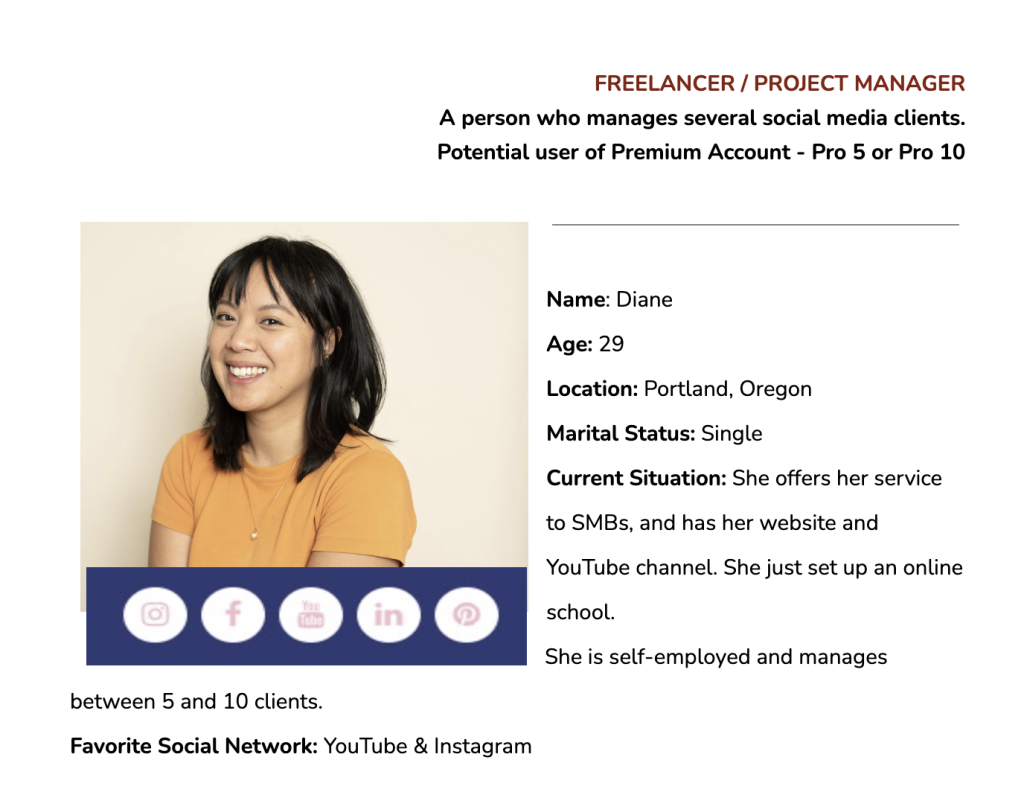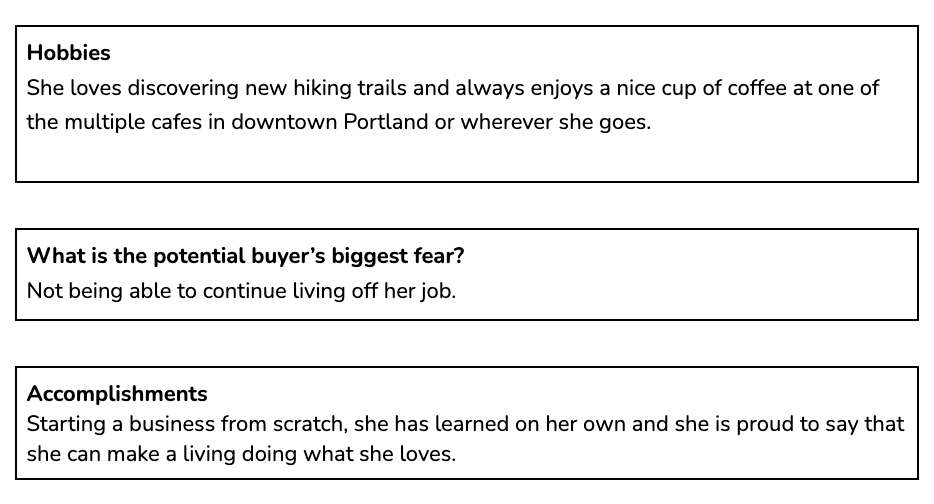How to Target Your Ideal Audience with Buyer Personas

Do you know who your ideal buyers are? As marketers, business owners, creators, etc. we are told repeatedly to find and market our target audience. This takes understanding what this person is looking for and what attracts them to engage in content, click through your website, and complete a purchase.
Although each individual may have unique buying tendencies, we can create hypothetical profiles of users with similar behaviors, backgrounds, and needs to actualize our ideal clients and resonate with our audiences.
What is a Buyer Persona?
Buyer personas are imaginary characters that represent your ideal clients. These include detailed descriptions based on your market research, including demographic details, career information, interests, pain points, goals, and buying tendencies.
Creating these buyer personas will help you better understand the characteristics and preferences of your potential customers, which can help guide your marketing strategies, messages, offers, and sales decisions.
Even if this persona isn’t 100% actualized, brands can personalize their marketing efforts and focus on customers’ real needs. When creating content and messaging, having these real-life case scenarios is important to resonate with your audience.
Buyer Persona Examples
So you may be wondering, what is included in this profile? Although this may look slightly different across industries, this file typically contains the following elements:
- Demographic information: This includes details such as age, gender, geographical location, language, education, income, profession, marital status, etc.
- Personal characteristics: Information on your persona’s interests, hobbies, values, attitudes, personality traits, or any other relevant aspect of personality.
- Goals and motivations: Identify the professional or personal goals your persona strives to achieve. What are their needs, aspirations, dreams, challenges, or concerns?
- Buying habits: Analyze your persona’s buying habits. What information-seeking channels does he or she use? What are their preferences in terms of purchasing decisions? What factors influence their decisions?
- Buying journey: Describe the stages your persona goes through during the buying journey. What are the points of contact with your company? What questions or obstacles does he encounter at each stage?
- Sources of information: Identify where your persona receives most of their information when researching products or services. These may include blogs, forums, social media, trade magazines, etc.
- Pain points: Write down any common problems or concerns your persona might have about buying your product or service. This will enable you to prepare appropriate responses to overcome these obstacles.
- Anecdotes: Add imaginary quotes or anecdotes, further personalizing your buyer persona to make it more realistic.
- Image or avatar: Include an image or avatar that visually represents your buyer persona. This will make the persona more concrete and easier for your team to visualize.


You can build this buyer persona file via a text document, table, graph, or pre-formatted template. The goal is to gather all of the important information about your ideal customer in an organized and accessible way, so you can refer back to this when developing and executing your marketing plan.
How many buyer personas should I create?
Although there isn’t a magic number for the amount of buyer personas you should create, each profile should reflect each segment of your market.
This can change depending on the diversity of your target audience and the variety of market segments you wish to reach.
However, creating too many buying personas can become difficult to manage and organize when it comes to creating a marketing strategy. Therefore, it’s better to focus on the most relevant segments of your business and how you wish to grow your brand.
Steps to Create a Buyer Persona
Creating a quality buyer persona involves several key steps to gather accurate information about your target audience. So, here are the general steps for creating a buyer persona:
✅ Research and data collection
In this first step, you must conduct in-depth research about your target market. To find this data, you can use sources such as:
- Demographic data
- Market research
- Surveys
- Interviews with existing customers
- Social media research
How can you find this information? Conduct generalized research for your target audience via Google searches, social media analytics tools, and statistical websites. Depending on your product, research buying tendencies per generation, most-used applications per age, application behaviors, etc. This information will guide your analysis and allow you to understand where your target audience hangs out.
✅ Data analysis and characteristic identification
The second step is to analyze your collected data to identify common trends, patterns, and behaviors among your target audience. Are there any significant similarities? Differences? These will help you build and divide ideal buyers per market segment.
In marketing, we know messages don’t resonate with everyone. That’s why it’s important to group these personas by shared characteristics, demographics, and interests. For each segment, identify key attributes such as age, gender, geographic location, education level, profession, interests, needs, goals, concerns, etc.
✅ Market segmentation
Now it’s time to segment your market into homogeneous groups with similar characteristics. Identify the segments most relevant to your business and offer significant opportunities. Once again, try to condense this as much as possible.
For example, one market segment could be, “Social media managers ages 18-25 that live in the United States.” These segments can be more broad to start and narrow down as you complete this research.
✅ Create buyer profiles
Now comes the fun part. Create fictitious buyer profiles based on the characteristics identified to represent each segment. Give each persona a name, an image, and a detailed description to make it more concrete and easy to understand.
Even if some of this information is made up, you can assume that the data is more or less accurate based on your analysis. Over time you can fine-tune these profiles to more accurately represent your ideal buyers.
✅ Validation and adjustments
Validate your buyer profiles by comparing them with real data and sharing them with team members or existing customers for feedback. Make adjustments based on additional information you may obtain.
✅ Using personas in your marketing strategy
Once you’ve created your buyer personas, use them as a guide to develop messages, content, and offers specific to each persona.
Tailor your communication channels and marketing strategies to the preferences and needs of each segment.
💡 Keep in mind that personas need to be flexible and scalable. Update them regularly as you acquire new information about your target audience.
4 Buyer Types and How to Target Them
In marketing, four common buyer types explain the reasons behind buying behaviors. Of course, not everyone can perfectly fit into one of these categories. But, to better understand the different personality types, let’s see the four buyer types:
The Analytical Buyer
Analytical buyers want to see the data before making a decision. They base most of their decisions on facts about a product or service, including exact figures and data. Therefore, they aren’t influenced by emotion or personal anecdotes. This type of buyer can be hard to influence since their purchase needs to be carefully calculated.
Providing as much factual information as possible is important to target this buyer. This can include sharing data studies, surveys, testimonials, success rates, and hard data to help answer these buyers burning questions and hesitations. Be ready to answer questions with hard facts and figures.
The Amiable Buyer
This next buyer can be influenced by emotion, but maybe not in the way you think. While they are extremely receptive to personal stories and experiences, they need to feel connected to your brand before making a purchase. They are interested in getting to know your business and value trustworthiness.
To best reach amiable buyers, focus on building relationships with these clients so they feel supported and united with your brand. Unlike analytical buyers, amiable buyers are not interested in the data as much and therefore may not be versed in the technicalities of your business. It’s important to lay out the details of your brand and how it can help them solve their pain points, help in their day-to-day, reach their goals, etc.
The Assertive Buyer
Assertive buyers know what they want, and often don’t want extra fluff. This can be a quick sales process if they are presented with the data up-front straightforwardly and transparently. Odds are, these buyers have already conducted research and are focused on results.
It’s important to focus on high professionalism when facing an assertive buyer. Come prepared with facts and how your products can support them to reach their end goal. Also, explaining your product’s competitive edge can help push a sale. What unique value does your brand offer?
The Expressive Buyer
Expressive buyers are similar to amiable buyers, dependent on relationships during the buying process. These buyers are driven by emotion and are moved by brands or businesses they feel connected to and supported by. Expressive buyers are also very intuitive, and will not follow through with a sale if they don’t feel aligned with a brand.
To best reach an expressive buyer, focus on effective communication, relationship building, and authenticity. This process may not be as quick as say an assertive buyer, however, these clients can be extremely loyal if acquired.
Buyer Persona Templates
Buyer persona templates are pre-formatted documents or forms that guide you through building a buyer profile. These templates usually include specific sections and questions to help gather demographic data, buying behaviors, motivations, goals, concerns, and other important details about this persona.
Here are a few sites that offer useful templates:
SEMRush Persona
This comprehensive audience analysis tool helps you understand your target audience. Through demographical data, interests, online behaviors, and other relevant information, SEMrush Persona creates detailed and accurate profiles of your ideal customers.
This enables you to optimize your marketing campaigns, personalize your content, and tailor your strategies to your audience’s needs and preferences.
With SEMrush Persona, you can make informed decisions to maximize the effectiveness of your actions and achieve your business objectives more quickly.
Visme Persona Template
Visme Persona Template is a ready-to-use template designed to create detailed and powerful audience profiles. This tool enables you to visualize and organize the characteristics, behaviors, and preferences of your target audience clearly and attractively.
With Visme Persona Template, you can easily capture essential information about your audience and share it with your team. It’s an effective way to understand your audience and personalize your marketing strategy accordingly.
Metricool Buyer Persona Template
We have created a comprehensive social media template with information to guide you through building a social media plan, buyer personas, a thorough strategy, and a weekly content plan. Access it here for FREE and create your ideal buyer personas.
In conclusion, buyer personas are invaluable resources for understanding and interacting with your target audience. By creating detailed profiles of your ideal customers, you can personalize your marketing strategies and deliver a more relevant experience to your prospects.

